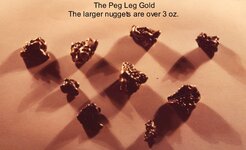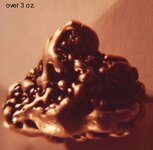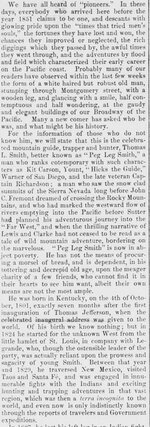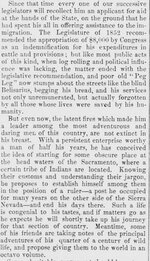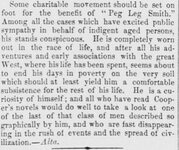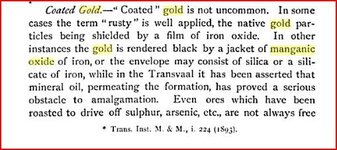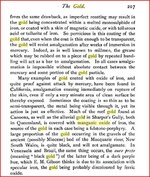Old Bookaroo
Silver Member
- Dec 4, 2008
- 4,475
- 3,801
PEGLEG IS A BLOOMING LIAR.
Los Angeles Herald, 18 May 1893 (Volume 40, Number 37)
Good luck to all,
~The Old Bookaroo
| His Mine Proved a Myth by Returned Prospectors. Ex-Sheriff Aguirre and a Party Return from a Fruitless Search. All Peg-leg's Old Landmarks Found and the Place Where the Mine Ought to Be, But No Gold Was to Be Found There. If the historical Pegleg mine had ever existed, Ed. Marcellus and his companion would probably have found it, but Mr. Mellus says there never was such a mine and states moreover that the imaginative Mr. Pegleg was a blamed old liar. Ex-Deputy Sheriff Mellus, who has so rudely torn away the veil of romance which has surrounded the lost El Dorado for over 30 years, has been a crank on the subject since he was 16, 18 years ago. Just 10 years back he made his first search for lost gold, taking the Hidden Springs as his object point. According to reliable information this hidden spring was in the locality of the mine and was necessary on account of the lack of water in the desert. With the aid of an Indian, who was informed that Mellus was hunting mountain sheep, the spring was found, in a little oasis covering about a quarter of an acre of territory. Satisfied with this result, Mellus returned to Los Angeles with the determination in resuming his search on the first opportunity. But funds were not plentiful and he never had that opportunity until last February, when Judge Brunson offered to grubstake him and his companions in their hunt for the long lost mine. On the 17th of February last Mellus, in company with his Cousin, F. O. Mellus, ex-Sheriff Martin Aguirre and a well-known prospector, Michael Kirby, started out with four horses and eight burros for the Colorado desert. They made for a little valley known as the "Vallecitos," intending to make that their headquarters. The journey was a long and rough one. Their progress was barred with the almost impenetrable jungles of cacti and prickly mescal plants through which the treasure seekers had to hew their way. The season was the rainy one, and the travelers often rode day and night through the pouring rain without finding shelter or dwelling of any kind. At last they reached the little valley and made their camp before commencing their march across the desert. After a short rest the burros were reladen and a start made for the three buttes, which old Pegleg had described as being the locality in which he found the shining gold in heaps. Taking warning from the fate of the numerous prospectors who bad lost their lives in the search, Mellus first saw to their water supply. Eight barrels, containing eleven gallons apiece, were packed on the burros, and the journey was begun. Some miles out the party overtook a female spiritualist medium in company with three Americans. The medium stated that she knew where the treasure lay and that she was going to the exact spot but she rather dispelled the illusion by asking Mellus and his companions in what direction the hidden spring lay. She did not receive a satisfactory answer. Mellus advised her to consult the spirits, and also warned her against undertaking the journey without water, drawing a graphic picture of death from thirst, which latter effort so scared the spiritualistic party that they incontinently turned tail and made for home. Not knowing exactly how long it would be before they reached the spring, the party determined to husband their water supply and for four days the unfortunate burros plodded along in the burning sand without a drop of water. At the best of times a burro is a sulky animal, and by the time the water was reached the beasts of burden were hot in both senses of the word. They were led to the stream with their four days' thirst on them, but in vain, the burros were dead sulky and would only look at the refreshing liquid and snort, and it was not until they thought they had evinced their sense of injustice that they would condescend to wet their lips. From this spring, which is so carefully concealed by nature that a man may be parching with thirst within 50 feet of it and not discover its existence, they made their way to the three historical buttes, along which, old Pegleg had stated, lay the gold. They were reached, and wasting no time the party commenced their search. Days and days were passed in fruitless hunting. There were no signs of gold. All of Pegleg's landmarks were found, all was there except the precious metal. The only approach to it, was a decomposed ledge running northwest and southeast. The ledge was honey-combed throughout, and the prospectors dug to depth of twenty feet, but when the dirt came to be washed, not even a color could be found. All that remained were small garnets none larger than a pin's head. The whole country for two miles around was thoroughly examined and at last the disgusted treasure seekers packed up and made their way back over the desert. Speaking to reporter yesterday, Mr. Mellurs [sic] said: "I want to say for the benefit of future prospectors that there is and can be no such place as the Pegleg mine. I have looked up old Pegleg's record, and judging from the evidence of his friends and acquaintances, the old man was a blamed old liar. He has been the cause of many a good man losing his life, and I want to say right here, that he was a fakir [sic] of the first water "The only foundation I can find for the story is that years ago, miners in going to Fort Yuma used to take the old Butterfield route, which leads in the direction of the supposed Pegleg mine. The Cahuilla Indians used to make a practice of ambushing these miners and robbing them of their gold duet. "I know for a fact that 17 miners were shot down at one time. The Indians, afraid to bring back this dust at one time, used to bury it in the desert, and account for their possession of it, by stating they had found a wonderful mine, the locality of which of course they would not describe. In my opinion this is the source of the story of the wonderful Pegleg mine. Old Pegleg drew on his imagination, which was a good one. Why, he said he got lost and woke up one morning to find glittering lumps of gold all round him. Why, the durned old “------ ------ ------ ----------" and in a disgusted tone of voice Mr. Mellus called for a drink. |
Los Angeles Herald, 18 May 1893 (Volume 40, Number 37)
Good luck to all,
~The Old Bookaroo


